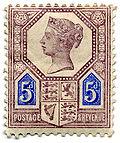
Jubilee Issue
Encyclopedia

Postage stamp
A postage stamp is a small piece of paper that is purchased and displayed on an item of mail as evidence of payment of postage. Typically, stamps are made from special paper, with a national designation and denomination on the face, and a gum adhesive on the reverse side...
s of the United Kingdom
United Kingdom
The United Kingdom of Great Britain and Northern IrelandIn the United Kingdom and Dependencies, other languages have been officially recognised as legitimate autochthonous languages under the European Charter for Regional or Minority Languages...
issued in 1887 are known as the "Jubilee" issue because they were issued during the year of the Golden Jubilee
Golden Jubilee
A Golden Jubilee is a celebration held to mark a 50th anniversary.- In Thailand :King Bhumibol Adulyadej, the world's longest-reigning monarch, celebrated his Golden Jubilee on 9 June 1996.- In the Commonwealth Realms :...
of the accession of Queen Victoria
Victoria of the United Kingdom
Victoria was the monarch of the United Kingdom of Great Britain and Ireland from 20 June 1837 until her death. From 1 May 1876, she used the additional title of Empress of India....
to the throne in 1837. They continued in use throughout the remainder of Victoria's reign, and many of the designs were reused in the stamps of Edward VII
Edward VII of the United Kingdom
Edward VII was King of the United Kingdom and the British Dominions and Emperor of India from 22 January 1901 until his death in 1910...
. They include the first British stamps to be printed in two colours.
Origins
The variety of colours and designs was partly in response to the much-disliked "Lilac and GreenQueen Victoria Lilac and Green Issue
The postage stamps of the United Kingdom issued in 1883 and 1884 are known as the “Lilac and Green” issue because they were only printed in those two colours; lilac being used for the ½d, 2d, 2½d, 3d values and dull green for the 4d, 5d, 6d, 9d and 1s....
" issues of 1883-1884. The 1884 Stamp Committee was formed to make decisions about improved replacements. After several meetings, and considering a number of essay
Essay
An essay is a piece of writing which is often written from an author's personal point of view. Essays can consist of a number of elements, including: literary criticism, political manifestos, learned arguments, observations of daily life, recollections, and reflections of the author. The definition...
s by De La Rue
De La Rue
De La Rue plc is a British security printing, papermaking and cash handling systems company headquartered in Basingstoke, Hampshire. It also has a factory on the Team Valley Trading Estate, Gateshead, and other facilities at Loughton, Essex and Bathford, Somerset...
(many of which survive in the marketplace), they produced a report recommending the use of surface printing
Surface printing
Surface printing is the oldest automated printing method still in use today. Surface machines lay down very heavy amounts of ink. Because the ink is pushed onto the paper, the images are not as crisp as the other methods. Also, there is no drying stage between laying down each color, so the...
, two colours in fugitive inks, coloured paper, and the dropping of the corner letters that had distinguished stamps on the sheet.

